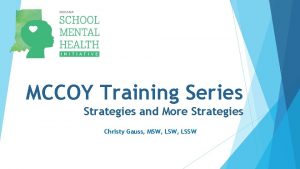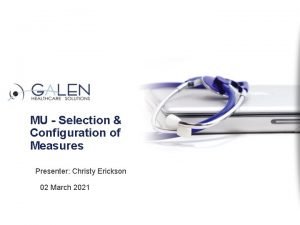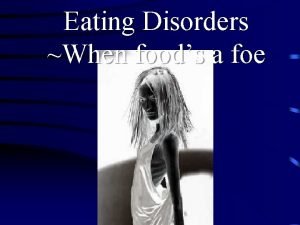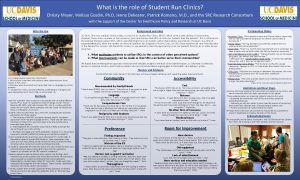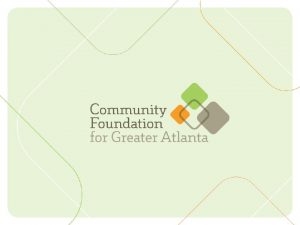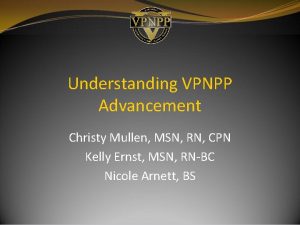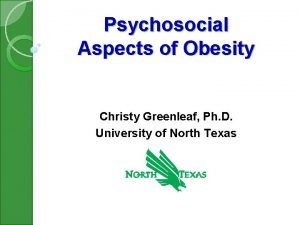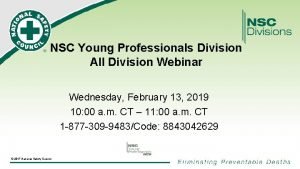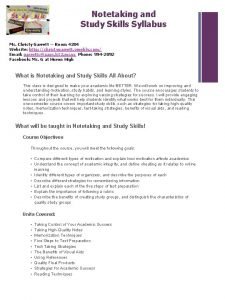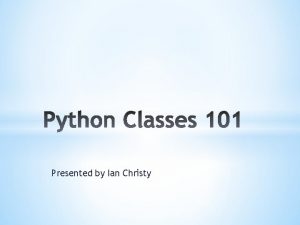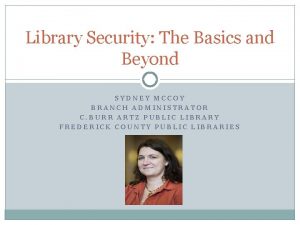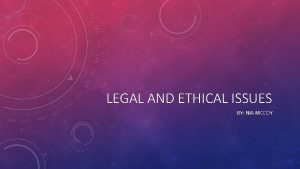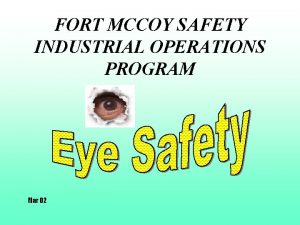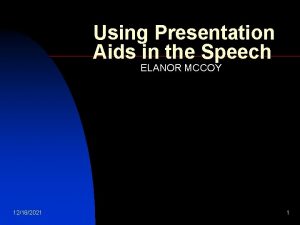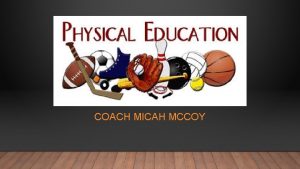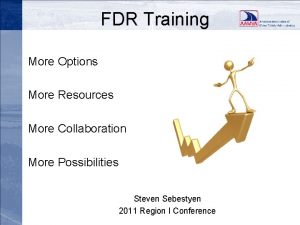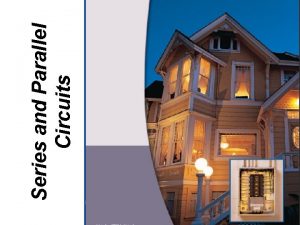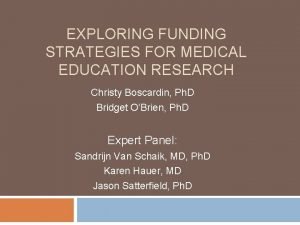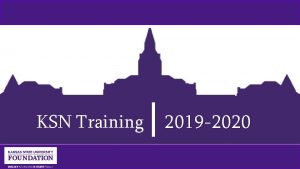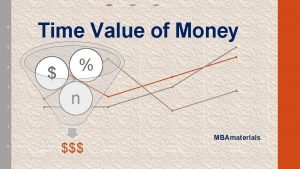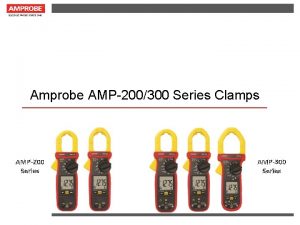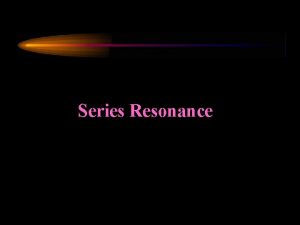MCCOY Training Series Strategies and More Strategies Christy






























- Slides: 30

MCCOY Training Series Strategies and More Strategies Christy Gauss, MSW, LSSW

“ Attachment is the carrier of all development. (Dr. Allan Schore) Link to Resources: https: //tinyurl. com/ychccrla ”

Let’s Refresh Our Memory “You cannot teach the mind until you reach the heart. ” Key takeaways from ACES and Dr. Lori presentations Two strategies you have implemented Anyone watch Inside Out? Thoughts?

Neuro-education recap Brains develop from the bottom up, and the inside out Main purpose of the brain is survival We are wired for connection Attachment is the carrier of all development Neuroplasticity: Our brains are highly malleable, especially during early years of life Strongest predictor of academic success are the social emotional variables your students bring in to the classroom

Backwards Bicycle

Trauma & Brain Development Typical Developmental Trauma Social/ Emotional Cognitio n Social/ Emotional Regulation Survival Cognition Adapted from Holt & Jordan, Ohio Dept. of Education

“ A study estimating the relative influence of 30 different categories of education, psychological, and social variables on learning revealed that social and emotional variables exerted the most powerful influence on academic performance. ” CASEL

6 Principles of Resiliency Always Empower Never Disempower Maintain High Expectations Check Assumptions, Observe and Question Be a Relationship Coach Guided Opportunities for Helpful Participation Provide Unconditional Positive Regard

3 Domains (What we teach) Under which to apply Principles (How we teach) Domain 1: Safety, Connection & Assurance Domain 2: Emotional and Behavioral Self. Regulation Domain 3: Competencies (of personal agency, social skills, academic skills)

Teaching Student’s About Their Brains! Teach students about their neuro-anatomy just as you would teach procedures, transition, classroom agreements and routines: Resources to teach the students about their brain: The Sentis Brain Animation Series https: //www. youtube. com/playlist? list=PL 53 n. CCe. Nj. RQDhbj. E 9 Ljvn. Fad-wd. B 5 bw 7 Prefrontal Cortex Teach the book Brain Rules by Medina Neuroplasticity The Teenage Brain Explained Amygdala Hippocampus Social Brain/Development/Peer Influence Stress Response/Limbic Brain Self-Reflection https: //www. youtube. com/watch? v=hidui. Tq 1 ei 8 Neuroscience for Kids http: //faculty. washington. edu/chudler/neurok. html Edutopia series: festival-brain-learning https: //www. edutopia. org/blog/film-

SENTIS Animation Series Sentis Animation Series

Kindergartener talking about his Neuroplasticity

Dr. Jill Bolte-Taylor: Teenage Brain (and more!)

3 Domains of Compassionate Schools Emotional connection in the #1 factor in changing the trajectory of ACES Domain 2 x 10, Bull’s Eye, My Rights/My Responsibilities, Validation Questions, Stars: Being Seen, Power of Stories Domain 1: Safety, Connection & Assurance 2: Emotional and Behavioral Self-Regulation Amygdala First Aid Stations, Brain Intervals, Focused Attention Practices, Mindfulness, Safe Keeper System, 90 Second Rule Domain 3: Competencies (of personal agency, social skills, academic skills) Service to others, Giraffe Talk, Positive Referral, SEL, Dual Think Sheets

Questions and Validation How can I help? That must have made you feel really angry. What do you need? What a frustrating situation to be in! Do you have a plan? It must make you feel angry to have someone do that. How can I help you? Wow, how hard that must be. - That’s stinks!- What are your resources? That’s messed up! What feels difficult? How frustrating! What could be the best possible outcome? Yeah, I can see how that might make you feel really sad. What is the worst thing that could happen? Boy, you must be angry. What a horrible feeling. What is a first step in improving this situation? What a tough spot. I hear you. I hear that. Other…

A Superintendent and His Amygdala: Video HSE Superintendent talking about 90 second rule and calming strategies

Boston 24/7 Taking a closer look at our Belief Systems!!

Boston 24/7

The Needed Perspective Shift “What’s wrong with you? ” “What happened to you & how can I help? ”

Where are your students? Where are you?

Above or Below the Line

Creating Resilient Teachers & Staff Self-care “Put is an ethical obligation Down the Mirror” Emotions are contagious Teachers/staff need to model the behaviors they want to see “We can’t teach what we don’t know. We can’t lead where we won’t go. ” (Malcom X)

Some ideas. . . Professional Quality of Life Scale (Pro. QOL R-IV) Teacher/Staff Amygdala Stations Space to talk about triggers/stresses (what are teachers/staff carrying in? ) How are we building community/relationships as a staff? Teams Promote Self-Care Checklist Mindfulness Newsletters (Mindfulness Mondays) Apps Stop, Breathe, Think 10% Happier Resources http: //www. 10 percenthap pier. com/mindfulnessmeditation-the-basics

Important for teachers/staff and students! “Resilience rests fundamentally on relationships. ” • Am I important to someone here? • Am I good at something here? • Can I affect the world here? • Can I share my gifts here? Suniya Luthar

Book Recommendations The Trauma Informed School: A step-by-step Implementation Guide for Administrators and School Personnel by Jim Sporleder & Heather Forbes Help for Billy by Heather Forbes Brain Rules by John Medina The Boy Who Was Raised as a Dog by Bruce Perry The Heart of Learning and Teaching: Compassion, Resiliency, and Academic Success You have this in Google Drive along with a book study My Stroke of Insight by Jill Bolte-Taylor The Price of Privilege by Madeline Levine Helping Traumatized Children by Massachusetts Advocates for Children: Trauma and Learning Policy Initiative

Video Recommendations How childhood trauma affects health across a lifetime|Nadine Burke Harris https: //www. youtube. com/watch? v=95 ov. IJ 3 ds. Nk The Backward Brain Bicycle: Teaching students about their neuroplasticity https: //www. youtube. com/watch? v=MFz. Da. Bz. Bl. L 0 The Science of Resilience: https: //www. youtube. com/watch? v=1 r 8 hj 72 bf. Go Changing The Lens Slide (Chad): https: //www. youtube. com/watch? v=s. FH 6 GR 0 ASKg&t=40 s What is Mental Health: https: //www. youtube. com/watch? v=Ar. OTqc. MH 2 G 0 Lutheran Foundation’s Reducing Stigma Video: https: //www. youtube. com/watch? v=d. Fokp 3 icz. Kw Teenage Brain Explained: https: //www. youtube. com/watch? v=hidui. Tq 1 ei 8 Trust/How to Train Your Dragon: https: //www. youtube. com/watch? v=6 MDCamj. AQVA How to start of movement: https: //www. youtube. com/watch? v=V 74 Ax. Cq. OTvg Josh Shipp Every Kid is One Caring Adult Away: http: //joshshipp. com/one-caring-adult/ ACES study: http: //kpjrfilms. co/resilience/bonus-content/ Bruce Perry 6 Developmental Strengths: https: //www. youtube. com/watch? v=ska. YWKC 6 i. D 4 Above/Below the Line: https: //www. youtube. com/watch? v=f. Lqz. YDZAq. CI Jill Bolte table/90 second rule/teenage brain https: //www. youtube. com/watch? v=Pz. T_SBl 31 -s http: //www. jbtbrains. org/ Dr. Siegel’s Hand/Brain Model: https: //www. youtube. com/watch? v=06 FUN 9 v. H 21 k

Questions? Final Thoughts

Go Start a Movement!!!! How to start a movement

Thank You! @IN_SMHI Indiana. SMHI Christy Gauss, MSW, LSSW School Mental Health Facilitator | IN School Mental Health Initiative Indiana Institute on Disability and Community|Indiana University Bloomington jcgauss@indiana. edu 317 -908 -0988

References Burke, N. J. , Hellman, J. L. , Scott, B. G. , Weems, C. F & Carrion, V. C. (June 2011). “The Impact of Adverse Childhood Experiences on an Urban Pediatric Population, ” Child Abuse and Neglect, 35, No. 6 Child Trends. (2014, July). Adverse Childhood Experiences: National and State-Level Prevalence. Retrieved from https: //www. childtrends. org/wp-content/uploads/2014/07/Brief-adverse-childhoodexperiences_FINAL. pdf Collaborative for Social, Emotional, & Academic Learning (CASEL). (2003). Safe and Sound: An Educational Leader’s Guide to Evidence-Based Social and Emotional Learning (SEL) Programs. Retrieved http: //indiana. edu/~pbisin/pdf/Safe_and_Sound. pdf Greenwald O’Brien, J. P. (2000), p. 597. See also Craig, S. (1992), p. 67. Kids Count Data Book (2017) https: //s 3. amazonaws. com/iyi-website/data-book/2017_Data. Book. pdf? mtime=20170227080137 National Alliance for Mental Illness (NAMI). (2014, June). Mental Health Facts: Children & Teens. Retrieved from https: //www. nami. org/getattachment/Learn-More/Mental-Health-by-the. Numbers/childrenmhfacts. pdf Perry, B. D. (2002). “Neurodevelopmental Impact of Violence in Childhood. ” In D. H. Schetky and E. P. Benedek (Eds. ), Principles and Practice of Child and Adolescent Forensic Psychiatry (pp. 191– 203; 200). Washington, DC: American Psychiatric Publishing, Inc Sporleder, J. and Forbes, H. T. (2016). The trauma-informed school: A step-by-step implementation guide for administrators and school personnel. Boulder, CO: Beyond Consequences Institute. Wolpow, R. , Johnson, M. , Hertel, R. & Kincaid, S. (2016). The heart of learning and teaching: Compassion, resiliency, and academic success. Washington State Office of Superintendent of Public Instruction.
 More more more i want more more more more we praise you
More more more i want more more more more we praise you More more more i want more more more more we praise you
More more more i want more more more more we praise you Mccoy.nxg strategies
Mccoy.nxg strategies Cutler friedmann and mccoy (1998)
Cutler friedmann and mccoy (1998) Katie mccoy starbucks
Katie mccoy starbucks Training is expensive without training it is more expensive
Training is expensive without training it is more expensive Christy erickson
Christy erickson Christy respress
Christy respress Pamela anderson eating disorder
Pamela anderson eating disorder Christy shifa clinic
Christy shifa clinic Christy seyfert
Christy seyfert Christy eckoff
Christy eckoff Christy moss
Christy moss Edna woolman chase
Edna woolman chase Vpnpp
Vpnpp Christy greenleaf
Christy greenleaf Mtss meme
Mtss meme Christy maes
Christy maes Christy garrett
Christy garrett Ian christy
Ian christy Christy vaughn
Christy vaughn Series aiding and series opposing
Series aiding and series opposing Human history becomes more and more a race
Human history becomes more and more a race Maclaurin series vs taylor series
Maclaurin series vs taylor series Balmer series lyman series
Balmer series lyman series Taylor series of composite function
Taylor series of composite function Taylor vs maclaurin
Taylor vs maclaurin P series server
P series server Amplifier feedback topologies
Amplifier feedback topologies Arithmetic series formula
Arithmetic series formula The more you take the more you leave behind
The more you take the more you leave behind


